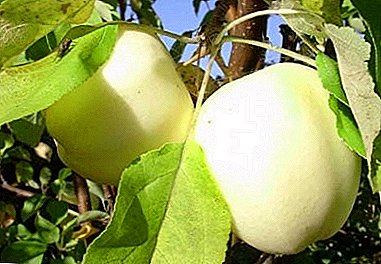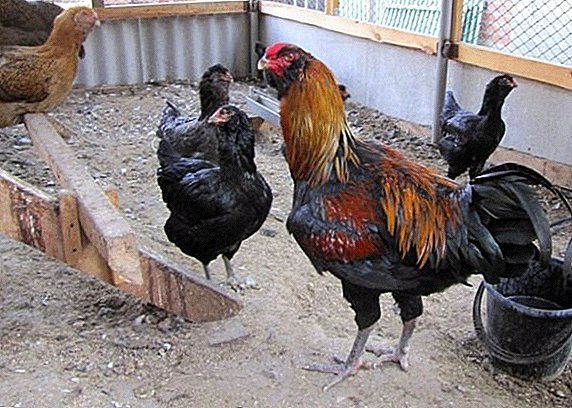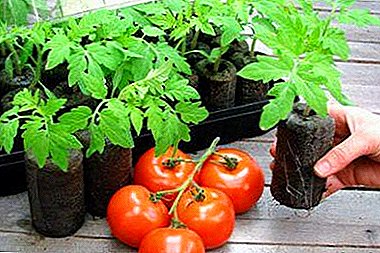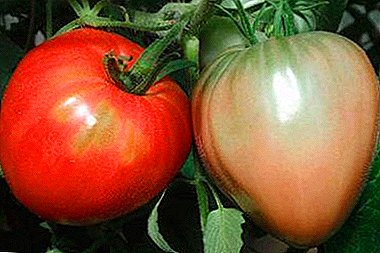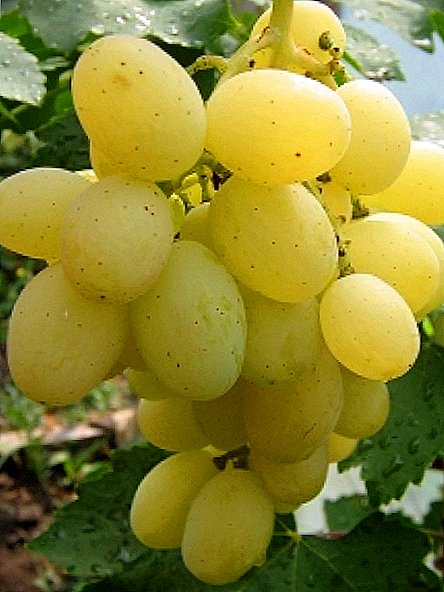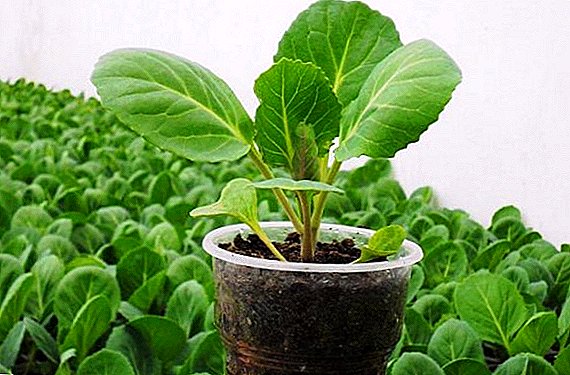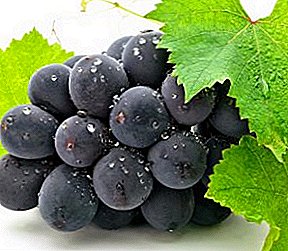 It is difficult to find a person who does not like grapes. Some people like white varieties more, others like dark ones, others don’t make differences based on color. And, by the way, it is completely in vain, because in this berry color really matters, and not only aesthetic. What is interesting is the black grapes, to whom it is useful, and how best to use this amazing gift of nature - the theme of our conversation today.
It is difficult to find a person who does not like grapes. Some people like white varieties more, others like dark ones, others don’t make differences based on color. And, by the way, it is completely in vain, because in this berry color really matters, and not only aesthetic. What is interesting is the black grapes, to whom it is useful, and how best to use this amazing gift of nature - the theme of our conversation today.
Calorie and chemical composition
Of course, speaking of the chemical composition and calorie content of grapes in general, only approximate figures can be cited, because much depends on the particular variety, on the place of growth and even on the degree of ripeness of the berry (for example, the percentage of sugar in grapes can vary from 14% to 23%, at the same time, if the berry is dried in raisins, the amount of sugar in it due to evaporation of water can reach up to 50%). 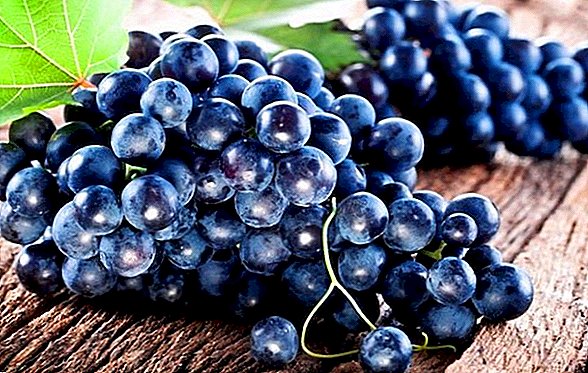 The same applies to calories. On average, we can talk about 60-75 kcal per 100 grams of product.
The same applies to calories. On average, we can talk about 60-75 kcal per 100 grams of product.
Approximately 80% of the grapes consist of water, 2-3% of the berry is ash, the rest is dietary fiber and carbohydrates, including sucrose, hexose, pentose, starch and cellulose.
Energy value of the berries:
- carbohydrates: 17% (approximately, sugar can be much more);
- Fats (including unsaturated, mono- and polysaturated fatty acids): 0.1-0.4 g;
- proteins: 0.6-0.7 g

The berry contains many vitamins, including:
- vitamin A (beta carotene);
- Vitamin B1 (thiamine);
- vitamin B2 (riboflavin);
- vitamin B4 (choline);
- vitamin B5 (pantothenic acid);
- Vitamin B6 (pyridoxine);
- Vitamin B8 (Inositol);
- vitamin B9 (folic acid);
- vitamin K (phylloquinone);
- vitamin C (ascorbic acid);
- vitamin E (tocopherol);
- vitamin PP (niacin).
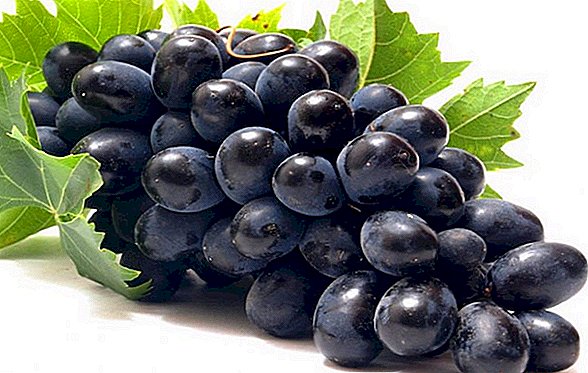
Among the minerals necessary for our bodies contained in grapes, the following should be mentioned:
- Ca (calcium);
- Mg (magnesium);
- K (potassium);
- Zn (zinc);
- Cu (copper);
- Mn (manganese);
- Fe (iron);
- Na (sodium);
- Se (selenium);
- P (phosphorus);
- F (fluorine).
In addition to the composition of the grape includes many other biologically active substances, and their full list to the end has not yet been studied. It is known that the berry contains tannins and pectins, glycosides, organic acids, natural dyes and flavors, peptides and amino acids, enzymes and biocatalysts. 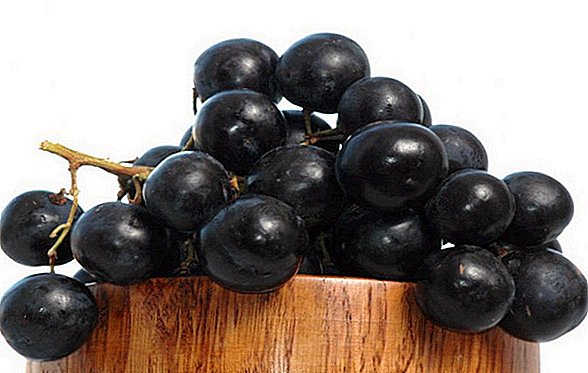 All of the above applies equally to any kind of grape. But dark varieties have one indisputable advantage compared to whites.
All of the above applies equally to any kind of grape. But dark varieties have one indisputable advantage compared to whites.
The dark color of the berries gives a special substance called resveratrol. This is a specific plant pigment, a type of polyphenol.
The value of this substance is that it has the ability to bind free radicals, resulting from the incomplete redox reactions that take place in our body. In other words, resveratrol is a natural antioxidant.
For the same reason, it is more beneficial to eat purple eggplants than white, red beans, than green, purple basil.
The highest content of resveratrol is in the skin of black grapes and its pits, which means that in no case should we spit out these parts of the berries. 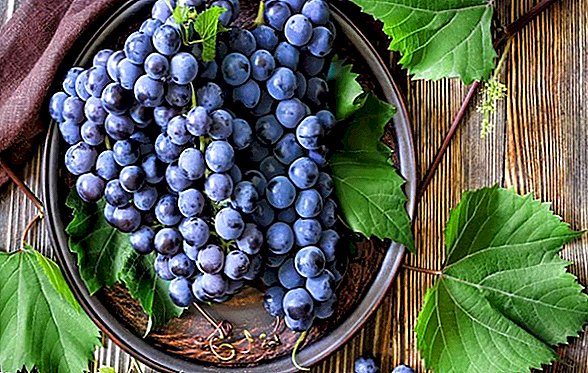 It is also found that the most useful are sour varieties of berries, their antioxidant properties are much higher.
It is also found that the most useful are sour varieties of berries, their antioxidant properties are much higher.
How is black grape useful?
On the ability of black grapes to help the body to cope with free radicals that are dangerous to our health and youth, we have already said. However, the above-described vitamin and mineral composition of the berries allows us to speak about a variety of other useful properties. Consider only some of them.
For immunity
Immunity, as we know, is a natural defense that our bodies builds against internal and external enemies.
The total and uncontrolled use of antibiotics, poor ecology and other negative factors destroy this natural barrier, which is why products that allow it to be restored without resorting to artificial immunomodulators acquire particular value. 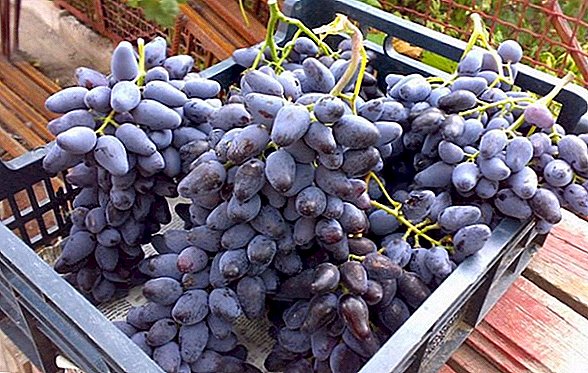 Black grapes strengthen the immune system in the same way as blueberries. And it's not just polyphenols and ascorbic acid.
Black grapes strengthen the immune system in the same way as blueberries. And it's not just polyphenols and ascorbic acid.
Did you know? In Spain and Portugal there is a New Year's custom: at the time of the beginning of the new year, with each beat of the clock, eat the grape and make a wish.
If resveratrol helps prevent premature old age, Alzheimer's disease, the development of inflammatory processes and other troubles, then pterostilbene (another immunostimulant contained in grapes) has anti-cancer activity, and, in addition, removes “bad” cholesterol from the body.
“Bad” cholesterol is also derived from jujube, iceberg lettuce, white currant, savoy cabbage, and fresh cucumbers.Resveratrol and pterostilbene with the participation of vitamin D stimulate the antimicrobial peptide cathelicidin, which is often called the nonspecific factor of local protection of the organism against various pathogens.
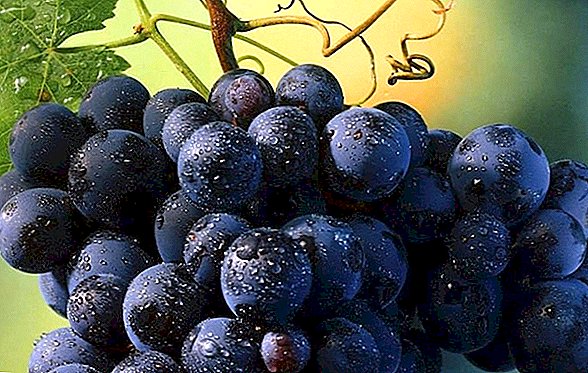
For the cardiovascular system
Black grapes have a beneficial effect on the cardiovascular system. The biologically active substances contained in the berries stimulate the production of nitric oxide in the blood, which thin the blood and prevent the formation of clots in it (blood clots).
As a result, the likelihood of heart attacks and strokes is dramatically reduced.
For the gastrointestinal tract
Black grapes stimulate the production of enzymes that are involved in the process of digesting food and regulate gastric motility.
Dark grapes are especially important in regulating pancreatic juice secretion, due to which sweet berries are used to treat functional disorders of the gastrointestinal tract, such as biliary dyskinesia, for example. 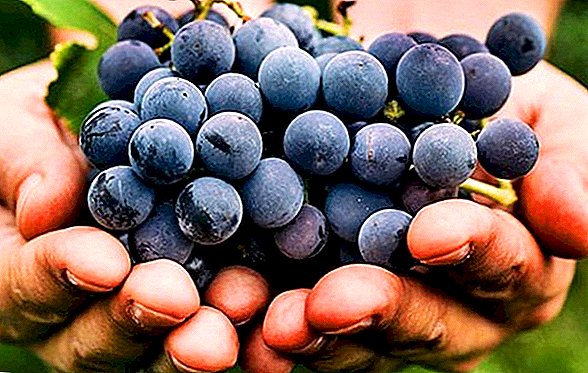 Eating grapes in small quantities increases the appetite, improves the bowels, "pushing" food waste, and preventing the development of constipation, and also relieves the feeling of heaviness after a dense meal.
Eating grapes in small quantities increases the appetite, improves the bowels, "pushing" food waste, and preventing the development of constipation, and also relieves the feeling of heaviness after a dense meal.
Parsley, turnip, green buckwheat, red currant, celery, honeysuckle, tomatoes improve intestinal function.
For kidney
Berries have a diuretic effect, and, therefore, have a beneficial effect on the work of the kidneys. In addition, this product stimulates the metabolic processes in the body, thereby preventing the accumulation of various waste products in it.
It is because of this property that grapes are an excellent prevention of gallstone disease, the formation of sand in the kidneys.
Did you know? In ancient times, grape harvest was a very dangerous occupation: the fact is that the trees growing nearby served as supports for the vine. Over time, the trees dried out, and the crop had to be removed even from their tops without any insurance.
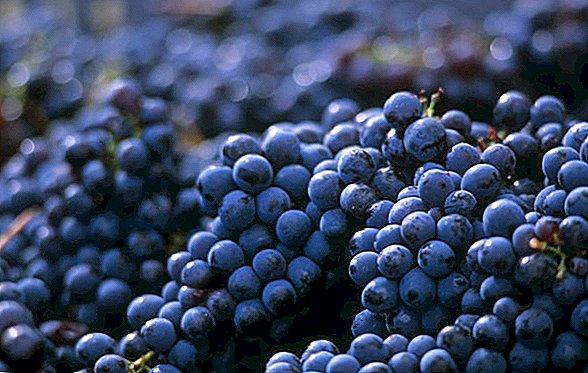 Americans call the so-called metabolic syndrome one of the most dangerous diseases of the 21st century.
Americans call the so-called metabolic syndrome one of the most dangerous diseases of the 21st century.This is a systemic pathology characterized by a simultaneous increase in blood sugar, high blood pressure and overweight. It is with this state that black grapes can fight in a complex.
For brain work
As you know, the brain needs sugar. However, candy as a mental "recharge" is not a very good solution, and the "slow" carbohydrates are digested too long to allow us to quickly cheer up when it is needed.
Chufa, northern bed-dresser, beet leaves, dried kumquat, dates, cress, cardamom, apricot, pumpkin honey contribute to the improvement of the brain.But black grapes, especially sweet wine varieties - exactly what you need. By the way, vitamin B6 contained in berries is also very necessary for our brain.
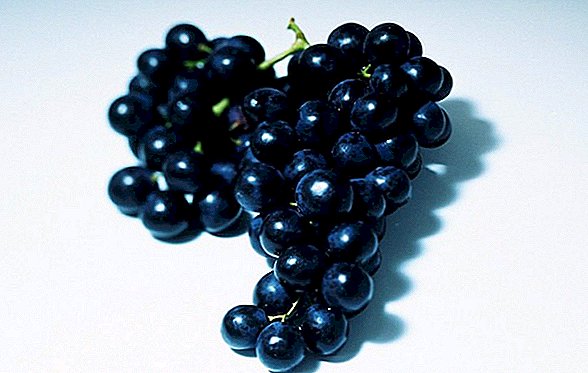
For the nervous system
Grapes contain a lot of magnesium, and this element, especially in tandem with the above-mentioned vitamin B6, allows the body to cope with the negative effects of stress (both physical and mental), emotional overstrain, depression, and neurosis.
Magnesium is also found in beans, cayenne pepper, cashews, mushrooms, persimmon, tomatoes, lychee.Magnesium helps our organs to "relax" by reducing the excitation of the central nervous system.
It is for this reason that the lack of magnesium instantly affects our state of health: we begin to experience inexplicable anxiety, sleep, attention and memory are disturbed, fatigue, irritability, causeless fears and headaches occur.
Regular consumption of black grapes and (in small, of course, quantities) good red wine will help to get rid of all this. 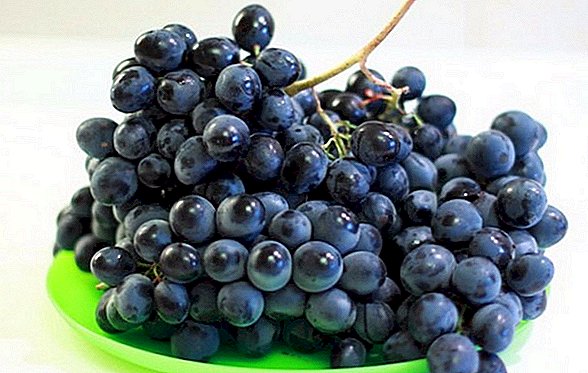
For skin, nails and hair
The antioxidant properties of grapes help prevent premature aging of the skin. Vitamin A contained in the berries also contributes to this.
Ascorbic acid protects the cells of our epidermis from the harmful effects of the environment, and B vitamins improve the condition of the skin, nails and hair. In addition, potassium helps to saturate the skin with moisture, and organic acids provide natural regeneration processes.
The result is obvious: those who eat a lot of grapes always look fresh and fit.
Did you know? In the south of France, the grape diet is very popular. Her secret is simple: the whole season, while the berry matures, people only eat it. Strangely enough, such an unbalanced diet does not lead to digestive disorders, but the number of oncological diseases in this region is much lower than the average.
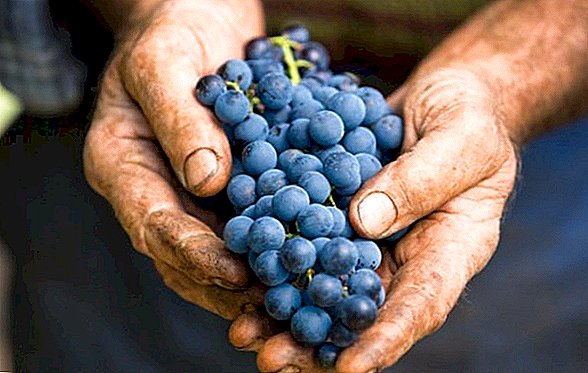 Grapes, by the way, are very often used as an ingredient in various cosmetic recipes. It is added to anti-aging and nourishing masks, as well as acne treatments and even sunscreens.
Grapes, by the way, are very often used as an ingredient in various cosmetic recipes. It is added to anti-aging and nourishing masks, as well as acne treatments and even sunscreens.Is it possible
About the general health benefits of berries, we already know. But there are certain "risk groups" - conditions where one should be especially careful with his diet.
For example, during pregnancy and lactation, in diabetes mellitus, as well as in childhood many useful and valuable products may be undesirable and even dangerous. Let's see if this rule applies to grapes.
Pregnant
Despite the fact that Many experts recommend future mothers to stop using grapes.These precautions have nothing to do with the official position of the World Health Organization. 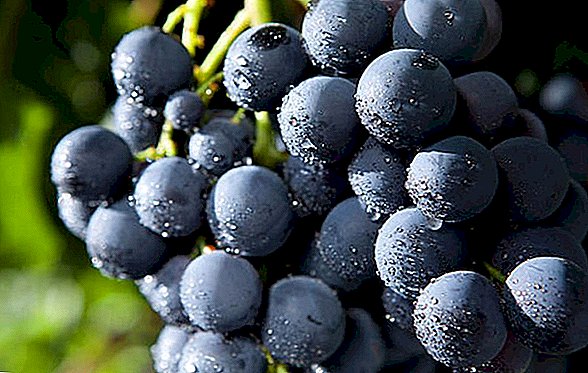
Important! During pregnancy, as well as during the breastfeeding period, alcohol is strictly contraindicated, therefore, red wine known for its benefits should also be forgotten for a while.
However, fresh berries and high-quality juice (without preservatives and dyes) can and should be consumed at this stage. It is only important not to abuse the product (given its high caloric content) and to ensure that no allergic reactions occur.
Along the way, we note that you should not be wary of consuming allergenic products, so as not to provoke a predisposition to allergies in a child.
Recent studies have shown that there is simply no direct connection between these events, but there is a reverse relationship: the sooner a child becomes acquainted with the allergen, the faster he will develop protection from him.  And one more precaution: the expectant mother should eat grapes separately from other fruits, heavy foods, as well as milk, mineral water and kvass, since such combinations are too strong a load for the stomach and can cause fermentation processes in the intestines.
And one more precaution: the expectant mother should eat grapes separately from other fruits, heavy foods, as well as milk, mineral water and kvass, since such combinations are too strong a load for the stomach and can cause fermentation processes in the intestines.
Nursing mothers
All of the above regarding pregnancy fully relates to the breastfeeding period.
Many nursing mothers are afraid of eating grapes, as this may cause colic to the baby. In this regard, it should be noted that the true cause of colic in babies until now has not been established by doctors.
As a version, indeed, the relationship between this disease state and the quality of milk is considered, which, in turn, is determined by the mother's diet. But this is only a version. 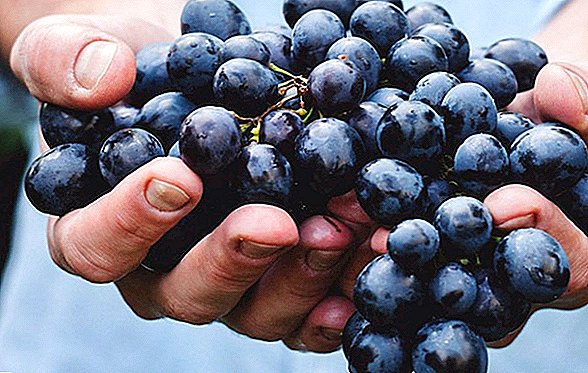 If your child does not have colic, it makes no sense to limit yourself to the use of useful berries. It is enough just not to lose the sense of proportion and avoid the dangerous combinations mentioned above.
If your child does not have colic, it makes no sense to limit yourself to the use of useful berries. It is enough just not to lose the sense of proportion and avoid the dangerous combinations mentioned above.
With diabetes
The "relationship" between grapes and diabetes is a complex and even debatable question.
In diabetes, it is recommended to use acacia honey, sorghum, orange, radish, blueberry, red currant, Chinese cabbage, amaranth tea.
Until recently, it was believed that, because the berry contains a huge amount of sugar, it should not be in the diabetic's diet on pain of death. However, as it turned out, everything is not so clear.
Firstly, the glucose and fructose present in the grapes help to increase the level of insulin in the blood, and, therefore, in diabetes mellitus of the first type, such a product is very much shown. 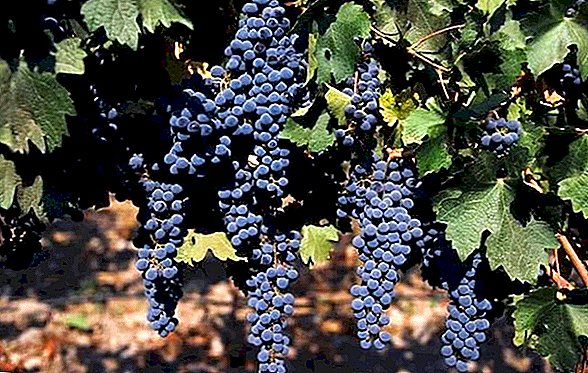 Secondly, even in the second form of diabetes, the berry can be useful. So, for the prevention of complications of the patient’s condition, he was recommended to use the grapes in a targeted manner, provided that they are dosed and the berry is chosen correctly.
Secondly, even in the second form of diabetes, the berry can be useful. So, for the prevention of complications of the patient’s condition, he was recommended to use the grapes in a targeted manner, provided that they are dosed and the berry is chosen correctly.
Important! In diabetes, you can eat only black grapes (white, as before, is contraindicated). Berry must be fresh and environmentally friendly.
For therapeutic purposes, the patient is recommended a treatment course of six weeks. It is necessary to begin the use with small doses, gradually increasing their quantity.
The recommended daily rate is 12 berries, while they need to be eaten in no case immediately, but after several (ideally - three) receptions. In the past two weeks, the daily rate should be reduced by half.  In addition, in the period of "grape therapy", milk and dairy products, pork, as well as other sweet vegetables and fruits should be completely excluded from the diet.
In addition, in the period of "grape therapy", milk and dairy products, pork, as well as other sweet vegetables and fruits should be completely excluded from the diet.
When losing weight
Another rather controversial issue is grapes and weight loss. Of course, the high sugar content in the product does not allow it to be considered dietary. And yet to say that you can gain extra weight from him is also wrong.
Absolutely harmless for the waist to use up to a half dozen large berries of dark varieties per day, the only condition: do not use them as a dessert after a dense meal, the product is best consumed separately from everything else. 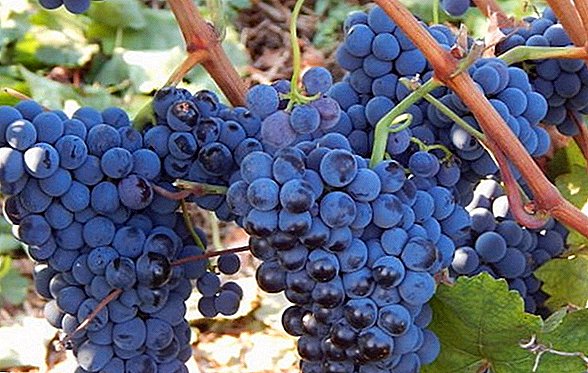
From what age can children
Oddly enough, the main danger of grapes for children is not in the chemical composition of the product, but only in its "physical" properties.
Important! Statistics show that grapes, along with nuts, chewing gum, candy, seeds and raw carrots, are products that are the most dangerous from the point of view of aspiration in children. In simple words, the child can easily choke with both grape seed and whole berries.
For this reason, you cannot treat children to grapes until they reach the age of one, and some doctors recommend refraining from such food for up to four years.
Of course, when giving a child grapes, it must be thoroughly washed beforehand: although the use of pesticides must be completed long before the formation of the bunch begins, it is better to be safe. 
The best black varieties
In order to describe all known varieties of black grapes, you will need more than one volume.
In addition to color, these berries can be divided into table, wild, dual-use and technical (wine). "Kishmish" is sometimes distinguished as a separate variety. As an example, we consider only a few of the most popular black grape varieties in the former USSR - table and wine.
Black grape varieties also include such as Ilya Muromets, Zilga, Alpha, Valiant, Krasnothop Zolotovsky, Furshetny, In Memory of Dombkovskaya, Cabernet Sauvignon.
"Athos"
"Athos" - table variety, bred as a hybrid relatively recently. "Parents" are two varietal species - "Codreanca" and "Talisman" (according to some sources - "Laura" and "Talisman"). Author selection - V.K. Bondarchuk.
The variety is characterized by a very early period (up to one hundred days in a temperate climate) and a very high percentage of aging. 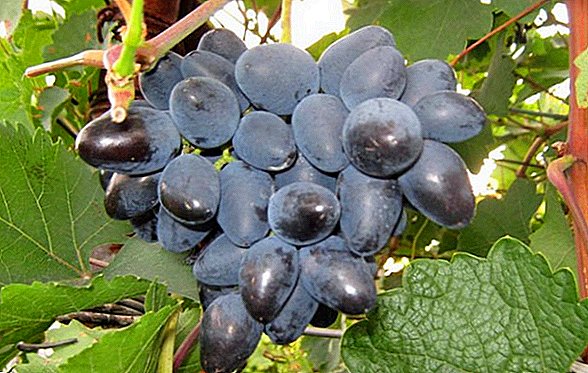
Did you know? For one bottle of wine you need to recycle 600-700 berries.
A full bunch of "Athos" consists of large berries of the same size. The weight of one berry can reach 13 grams, while some clusters can “pull” one and a half kilograms or more.
The berries are dark blue, almost black, oval-elongated or finger-shaped. The skin of the berries of medium thickness. When digging through the berry crunchy, with juicy thick pulp.
The taste of the well ripened grapes "Athos" resembles "Codreanca", however, it has a more pronounced harmonious aroma and higher sugar.
Baikonur
Baikonur is another relatively young hybrid, but it has already managed to declare itself in the expert environment as one of the best modern hybrid forms of grapes that have the prospect of market cultivation.  The same as "Athos", refers to table varieties. Ранние сроки вызревания (в среднем 110 дней), высокое сахаронакопление (до 20%), отличная урожайность - главные качества, способствующие популяризации данного сорта.
The same as "Athos", refers to table varieties. Ранние сроки вызревания (в среднем 110 дней), высокое сахаронакопление (до 20%), отличная урожайность - главные качества, способствующие популяризации данного сорта.
Родительские сорта - "Красотка" и "Талисман". Автор селекции - виноградарь-любитель Е.Г. Pavlovsky.
Freely located berries of "Baikonur" gather in clusters of a truncated-conical, sometimes conical shape, medium dense structure. Ripe berries are very large, evenly colored in dark cherry-purple hues, with a very elongated, cocoa-like shape.
The weight of an average berry reaches 16 grams, and its length is up to 4 centimeters.
Under the average thickness of the peel hides the dense flesh of excellent taste with light shades of fruit flavors, so that the grapes of this variety is perfect for use in fresh form. 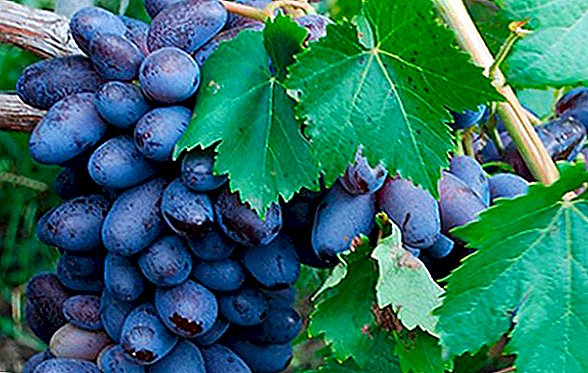 Despite the thickness, the skin during food is easily chewed, and two or three small bones do not cause any noticeable inconvenience.
Despite the thickness, the skin during food is easily chewed, and two or three small bones do not cause any noticeable inconvenience.
"Codrean"
“Codreanca” is a no less successful hybrid variety of black table grapes. It has a period of ripening of the crop, which can be described as very early (110-118 days), well-ripened berries contain 18-19% sugar. Parental varieties - "Moldova" and "Marshall".
The cluster of “Kodryanki” weighs, on average, about half a kilo, although there are especially large ones - up to one and a half kilograms.
The berries are dark purple, densely planted, large enough (3x2 centimeters), ovoid or oval. The pulp is dense, with a rich grape taste of nutmeg shades. Bones are present, but they are few, and they are easily separated during meals. 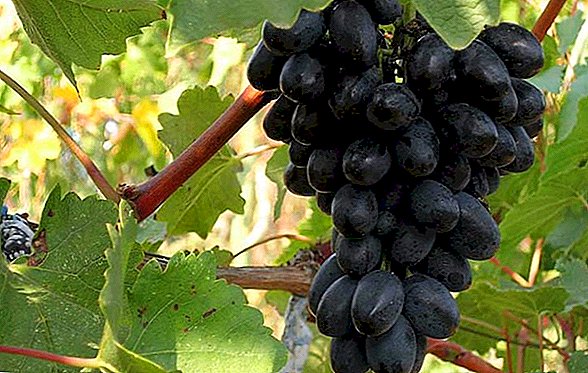 Like most black table grapes, Codreanka has enhanced antioxidant properties, is able to bind and excrete radionuclides and heavy metals from the human body, and has a beneficial effect on the immune system, increasing the overall tone.
Like most black table grapes, Codreanka has enhanced antioxidant properties, is able to bind and excrete radionuclides and heavy metals from the human body, and has a beneficial effect on the immune system, increasing the overall tone.
"Pearls"
Black "Pearl", in contrast to the three table varieties described above, refers to the wine-technical varieties of the early (120-130 days) maturity with an increased (up to 24%) sugar content in the ripe berry.
The variety is the result of breeding two hybrids. Parental varieties - a hybrid "Augustus" on the "Amur" and a hybrid "Centaur of Magarach" on the "Levokumsky". Variety since 2005 is used in industrial winemaking.  The bunch of "Pearls" is usually of medium size, weighs up to three hundred grams, has a cylindrical shape first, then a conical shape. The berries are small, loosely spaced, slightly elongated, with a thin skin of dark blue.
The bunch of "Pearls" is usually of medium size, weighs up to three hundred grams, has a cylindrical shape first, then a conical shape. The berries are small, loosely spaced, slightly elongated, with a thin skin of dark blue.
The flesh is thick, juicy, with a pleasant nutmeg aroma.
"Prince"
This is another representative of technical varieties of early-medium (125 days) ripening with a very high degree of sugar accumulation. In terms of origin, the variety has French roots.
The grapes are distinguished by large, conical shapes of bunches, weighing, on average, about a kilogram. Berries - huge, egg-shaped, weighing 10-12 grams, with fleshy aromatic pulp. 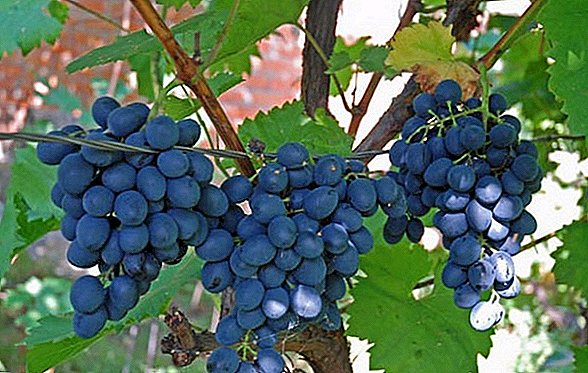
Important! Grapes "Prince" should not be confused with another variety - "Black Prince". This is a different name for the famous Moldova table grape variety, which is distinguished by its lower sugar content, modest size and late fruit ripening.
"Pino"
Black grape "Pinot" (Pinot noir) - one of the most time-tested wine varieties bred in the province of Burgundy (France) in the middle of the last century.
The wine varieties include such as "Jupiter", "Lydia", "Riesling", "Chardonnay".
Today, varieties obtained as a result of clonal selection are cultivated throughout the world.
As a true elite wine variety, "Pinot noir" can boast neither fast aging (140-150 days on average), nor the size of the brush (average weight 100-120 grams), nor the size of the berries (they are small, tightly planted, often deformed) nor extreme sugar accumulation (average sugar content at the level of 20%). 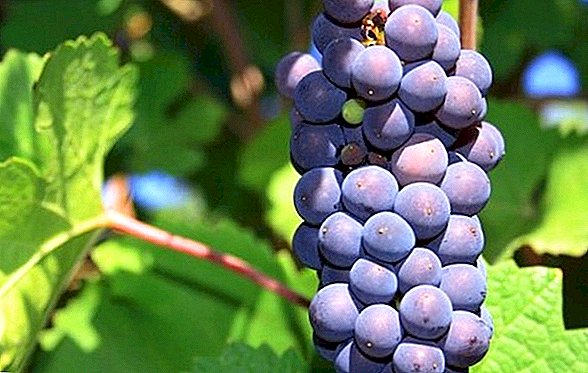 Nevertheless, it has been the most popular and widespread variety as a raw material for the production of high-quality vintage wines for more than eight decades, in many wine-making regions, including far beyond the borders of France.
Nevertheless, it has been the most popular and widespread variety as a raw material for the production of high-quality vintage wines for more than eight decades, in many wine-making regions, including far beyond the borders of France.
"Odessa"
"Odessa" - a young hybrid variety of black grapes for technical purposes. Breeding name - "Alibern." It is zoned for cultivation in wine-making farms of the Odessa and Nikolaev areas of Ukraine.
In terms of ripening harvest refers to the late (160-165 days), fully ripened berries contain 18-23% sugar. Parental varieties - "Alicante Bush" and "Cabernet Sauvignon".
The cluster is small (average weight 150-200 grams), crumbly, folded from small berries of a round shape, with a strong skin, and an incredibly deep ruby shade.  Due to its properties it is used mainly in the production of ordinary red dessert and table wines.
Due to its properties it is used mainly in the production of ordinary red dessert and table wines.
What can be done
Table grapes are different from the wine ones, that they have a beautiful appearance, perfectly balanced taste and a minimum number of seeds. Such grapes are best eaten fresh.
Berry technical varieties has a different purpose. It can be small and unsightly, have a lot of bones and thick skin, quickly deteriorate. In addition, the sugar in such fruits is much more than it can be useful if there are handfuls of them.
Therefore, to talk about what can be made from grapes, can only be applied to a particular variety. But there are, of course, exceptions to the rule.  Theoretically, raisins can be made from any variety (dried berries outdoors, in an oven or dryer), but we would not recommend doing this. For the preparation of raisins, there is a special type of grape, it is called "Kishmish".
Theoretically, raisins can be made from any variety (dried berries outdoors, in an oven or dryer), but we would not recommend doing this. For the preparation of raisins, there is a special type of grape, it is called "Kishmish".
Learn about the agronomist cultivation of grapes souring, as well as varieties such as "Kishmish Zaporozhye", "Kishmish radiant".These varieties are considered the least useful and valuable, but their main difference is the absence of seeds, because the seeds in the raisins are absolutely superfluous.
Grape juice can be made from any grape, but initially technical varieties are still used for this purpose (table berries are too good to crush).
Grape preserves are not a very common option, but, nevertheless, possible. Sugar should be added quite a bit to this berry (no more than 800 g per kilogram of fruit), and the result is very unusual: black grapes give the jam a noble burgundy color and rich taste. 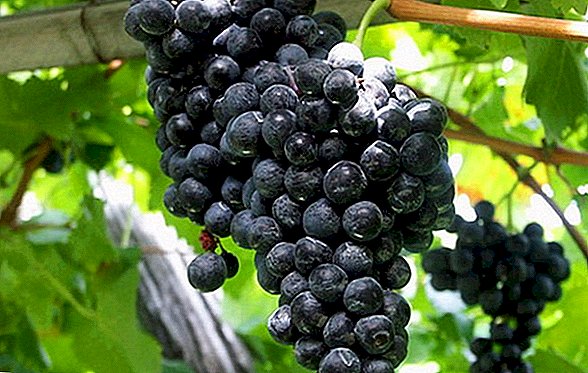 But still the main way of “harvesting” black grapes is a great homemade wine. Even from table varieties (if you already have an excess of berries and do not know how to use it so that the harvest is not lost) you can get a drink of excellent quality, you just need to know certain secrets and comply with the technology.
But still the main way of “harvesting” black grapes is a great homemade wine. Even from table varieties (if you already have an excess of berries and do not know how to use it so that the harvest is not lost) you can get a drink of excellent quality, you just need to know certain secrets and comply with the technology.
Important! To prepare a good wine from the "wrong" grapes you need to use special wine yeast. They can easily be purchased online. Berries before cooking must be washed from their own "wild" yeast. In addition, intending to make wine from table grapes, you need to adjust the amount of sugar added to the drink upwards.
In addition to the wine, from the berries you can also make brandy or brandy. This will require more time and effort, in addition, you need to have special equipment for the distillation of grape mash into alcohol, which later will need to be insisted in oak barrels or simply on certain types of herbs, including oak bark. 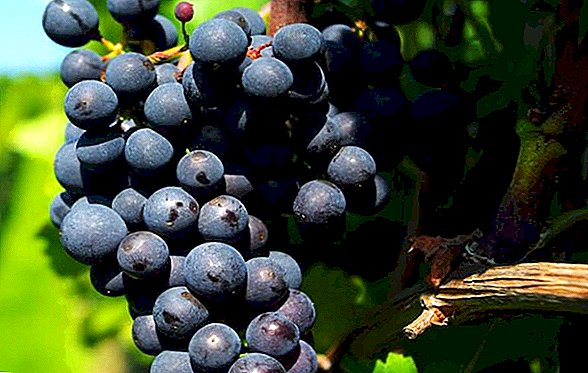 And if you marinate young grape leaves with salt, sugar, vinegar and spices, in the winter you will have an excellent preparation for the preparation of fragrant dolma - the eastern version of cabbage rolls, in which grape leaves are used instead of cabbage.
And if you marinate young grape leaves with salt, sugar, vinegar and spices, in the winter you will have an excellent preparation for the preparation of fragrant dolma - the eastern version of cabbage rolls, in which grape leaves are used instead of cabbage.
What could be the harm
Uncontrolled use of grapes can lead to a set of extra pounds, cause an allergic reaction, provoke gastric upset. Fruit acids contained in a berry have a detrimental effect on tooth enamel; people who have teeth with caries should be especially careful.
Important! There is only one parameter in which black grapes yield to white. This is an allergy. As a general rule, the darker the berry, the more useful it is. However, with an increase in the intensity of dark color, the allergenicity of the product also increases.However, the “danger” that grapes harbor is incomparable with its benefits. It is enough just not to abuse the berry, not to mix it with other products (especially those that cause fermentation) and rinse your mouth after a pleasant meal.

Who can not eat
And yet there are times when using grapes should be approached with extreme caution.
To limit the use of this product is the presence of:
- stomach ulcers or duodenal ulcers;
- type 2 diabetes;
- overweight;
- gastrointestinal disorders (diarrhea, colitis);
- caries or stomatitis;
- high blood pressure;
- cirrhosis of the liver;
- thyroid and kidney problems.
A separate reason to refrain from berries - taking drugs with a high content of potassium. 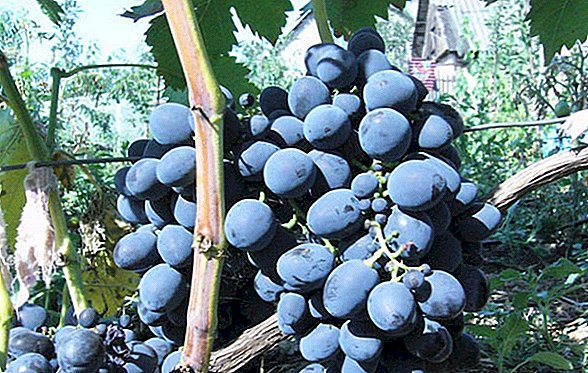 So, among all types of grapes, black is the most useful. It has a beneficial effect on almost all organs and systems, makes us younger, more beautiful, more active and even smarter.
So, among all types of grapes, black is the most useful. It has a beneficial effect on almost all organs and systems, makes us younger, more beautiful, more active and even smarter.
Subject to the measure and some simple rules, the berries have almost no contraindications. A rich and rich wine that can be obtained from them is truly a drink of the gods.



